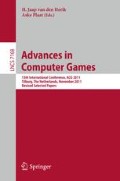Abstract
The landscape of an objective function for supervised learning of evaluation functions is numerically investigated for a limited number of feature variables. Despite the importance of such learning methods, the properties of the objective function are still not well known because of its complicated dependence on millions of tree-search values. This paper shows that the objective function has multiple local minima and the global minimum point indicates reasonable feature values. Moreover, the function is continuous with a practically computable numerical accuracy. However, the function has non-partially differentiable points on the critical boundaries. It is shown that an existing iterative method is able to minimize the functions from random initial values with great stability, but it has the possibility to end up with a non-reasonable local minimum point if the initial random values are far from the desired values. Furthermore, the obtained minimum points are shown to form a funnel structure.
Access this chapter
Tax calculation will be finalised at checkout
Purchases are for personal use only
Preview
Unable to display preview. Download preview PDF.
References
Anantharaman, T.: Evaluation tuning for computer chess: Linear discriminant methods. ICCA Journal 20, 224–242 (1997)
Baxter, J., Tridgell, A., Weaver, L.: TDLeaf(λ) Combining temporal difference learning with game-tree search. In: Proceedings of the 9th Australian Conference on Neural Networks (ACNN 1998), Brisbane, Australia, pp. 168–172 (1999)
Baxter, J., Tridgell, A., Weaver, L.: Learning to play chess using temporal-differences. Machine Learning 40, 242–263 (2000)
Beal, D.F., Smith, M.C.: Temporal difference learning applied to game playing and the results of application to shogi. Theoretical Computer Science 252, 105–119 (2001)
Campbell, M., Joseph Hoane, J.A., Hsu, F.: Deep Blue. Artificial Intelligence 134, 57–83 (2002)
Conn, A.R., Scheinberg, K., Vicente, L.N.: Introduction to Derivative-Free Optimization. MPS-SIAM Series on Optimization. Society for Industrial and Applied Mathematics (SIAM), Philadelphia (2009)
Fürnkranz, J.: Machine Learning in Games: A Survey. In: Fürnkranz, J., Kubat, M. (eds.) Machines that Learn to Play Games, pp. 11–59. Nova Science Publishers (2001)
Hoki, K., Kaneko, T.: Large-Scale Optimization of Evaluation Functions with Minimax Search (in preparation)
Hoki, K.: Bonanza – The Computer Shogi Program (2011) (in Japanese), http://www.geocities.jp/bonanzashogi/ (last access: 2011)
Hoki, K.: Optimal control of minimax search results to learn positional evaluation. In: Proceedings of the 11th Game Programming Workshop (GPW 2006), Hakone, Japan, pp. 78–83 (2006) (in Japanese)
Hyatt, R.: Crafty 23.4 (2010), ftp://ftp.cis.uab.edu/pub/hyatt
Kaneko, T.: Learning evaluation functions by comparison of sibling nodes. In: Proceedings of the 12th Game Programming Workshop (GPW 2007), Hakone, Japan, pp. 9–16 (2007) (in Japanese)
Knuth, D.E., Moor, R.W.: An Analysis of Alpha-Beta Pruning. Artificial Intelligence 13, 293–326 (1991)
Letouzey, F.: Fruit 2.1 (2005), http://arctrix.com/nas/chess/fruit
Marsland, T., Campbell, M.: Parallel Search of Strongly Ordered Game Trees. ACM Computing Survey 14, 533–551 (1982)
Marsland, T.A.: Evaluation-Function Factors. ICCA Journal 8, 47–57 (1985)
Marsland, T.A., Member, S., Popowich, F.: Parallel game-tree search. IEEE Transactions on Pattern Analysis and Machine Intelligence 7, 442–452 (1985)
Nocedal, J., Wright, S.: Numerical Optimization. Springer (2006)
Nowatzyk, A.: (2000), http://tim-mann.org/DTevaltune.txt (last access: 2010)
Romstad, T.: Stockfish 1.9.1 (2010), http://www.stockfishchess.com
Schaeffer, J., Hlynka, M., Jussila, V.: Temporal difference learning applied to a high-performance game-playing program. In: Proceedings of the 17th International Joint Conference on Artificial Intelligence (IJCAI 2001), pp. 529–534. Morgan Kaufmann Publishers Inc., San Francisco (2001)
Shannon, C.E.: Programming a Computer for Playing Chess. Philosophical Magazine, Ser. 7 41(314) (1950)
Sun, W., Yuan, Y.-X.: Optimization Theory and Methods. Nonlinear Programming. Springer Science+Business Media, LLC (2006)
Tesauro, G.: Comparison training of chess evaluation functions. In: Furnkranz, J., Kumbat, M. (eds.) Machines that Learn to Play Games, pp. 117–130. Nova Science Publishers (2001)
Tesauro, G.: Programming backgammon using self-teaching neural nets. Artificial Intelligence 134, 181–199 (2002)
Veness, J., Silver, D., Uther, W., Blair, A.: Bootstrapping from game tree search. In: Bengio, Y., Schuurmans, D., Laerty, J., Williams, C.K.I., Culotta, A. (eds.) Advances in Neural Information Processing Systems 22: 23rd Annual Conference on Neural Information Processing Systems, Vancouver, BC, Canada, pp. 1937–1945 (2009)
Yamashita, H.: YSS 7.0 – data structures and algorithms (in Japanese), http://www32.ocn.ne.jp/~yss/book.html (last access: 2010)
Author information
Authors and Affiliations
Editor information
Editors and Affiliations
Rights and permissions
Copyright information
© 2012 Springer-Verlag Berlin Heidelberg
About this paper
Cite this paper
Hoki, K., Kaneko, T. (2012). The Global Landscape of Objective Functions for the Optimization of Shogi Piece Values with a Game-Tree Search. In: van den Herik, H.J., Plaat, A. (eds) Advances in Computer Games. ACG 2011. Lecture Notes in Computer Science, vol 7168. Springer, Berlin, Heidelberg. https://doi.org/10.1007/978-3-642-31866-5_16
Download citation
DOI: https://doi.org/10.1007/978-3-642-31866-5_16
Publisher Name: Springer, Berlin, Heidelberg
Print ISBN: 978-3-642-31865-8
Online ISBN: 978-3-642-31866-5
eBook Packages: Computer ScienceComputer Science (R0)

